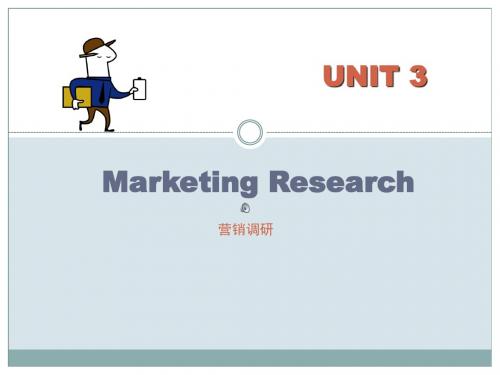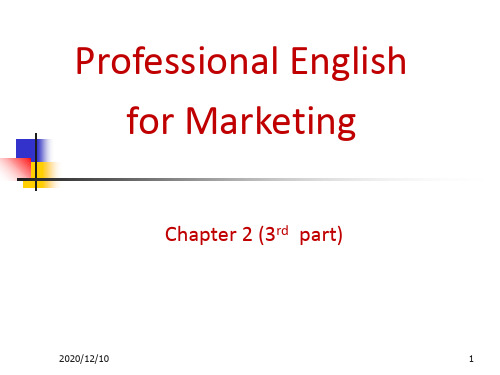市场营销英文Chapter 3
新职业英语市场营销英语Unit3 pricing文档可编辑修改

- 8 - 2019/12/2
Reading A
声音
翻译
? External Factors
? Pricing very often has to take into account external factors, especially in the case of consumer goods. Indians are among the world's most price sensitive customers. Yet, many MNCs (multinational companies) operating in India ignore the mass market and launch products for the upper end of the market only. Consequently, their ability to build volume is threatened. For example, when Levi's entered India in June 1995, it was expected to do well, as it had the advantage of owning one of the leading brands in the world. By mid 1998, Levi's realized that it was going nowhere. Teenagers perceived Levi's products, priced at over 2,000 rupees, to be too expensive, forcing the company to tone down its premium image. Nike also started marketing its brands in India in 1995. Until April 1999, however, all Nike's products were priced at 2,500 rupees and above. Needless to say, volumes did not pick up. In July 1999, Nike introduced sneakers priced at 999 rupees to meet the needs of entry level sports enthusiasts.
市场营销(双语教程)Chapter 3 Analysis of Marketplace

3.3.4 Cultural Factors
Cultural factors include cultural and sub-cultural groups, religion, consumer habits, aesthetic interest and values. 1. Culture and Sub-Culture 2. Religious Belief, Consumer Habits, Aesthetic Interest and Values
1. Population Size 2. Population Growth 3. Population Structure 4. Population Move
3.3.2 Economic Factors
Economic factors are major determinants to achieve demand. Without a population of a given quantity there would be no market. Likewise no demand will be generated without a purchasing power. 1. Income 2. Savings and Credit 3. Expenditure Pattern of Disposable Income
3.1.2 Division of Marketplace
1. Division by Circulation Area It can be divided into domestic market and international market. The domestic market can also be subdivided into urban market and rural market, local market and non-local market. 2. Division by Form of Product It can be divided into tangible market, intangible market and monetary capital market. 3. Division by Basic Situation of Market Operation It can be divided into seller’s market, buyer’s market and equilibrium market. 4. Division by Mode of Market Transaction It can be divided into spot market, futures market and credit market. 5. Division by Buyers and Purchase Motivation It can be divided into consumer market and organizational market. The organizational market covers producer market, intermediary market and government market.
营销英语 unit 3

体地理区域内、某一特定顾客群体的市场信息的过程。
Section I Special Terms
Marketing Research Marketing research is meant to encompass research practices (including such techniques as surveys, focus groups, interviews, and
Section II
Text Study
Pre-reading questions
1. What is marketing research? 2. Do you think marketing research is important or not, why? 3. How many approaches are available to a market researcher?
C. 途径
D. 修改 E. 味道
F. 明确的
G. 概括的 H. 问卷
Section II
Exercise 3
Text Study
Fill in the blanks with the appropriate form of the words in brackets.
Many companies have their own marketing research departments. However, due to limited market research companies (limit) corporate resources, more independent are hired (hire) to conduct research. The might (may) maintain a large
市场营销专业英语_chapter_2_3PPT教学课件

Buyer responses Pro duct choice Brand choice Dealer choice Purchase timing Purchase amount
Source: Russell S. Winer, Marketing Management, 清华大学出版社, 2002
Words and Expressions 2
dealer n. 经销商 turn or change A into B e. 把A转变成B
nature of sth. n. 某事物的特征或本质
influence=affect vt. 影响…
satisfy or meet a need e. 满足需求
2020/12/10
6
2.3.2 The Buyer Decision Process for New Products (购买者对新产品的决策过程模型)
Stages in the Adoption Process(采纳过程模型)
Consumers go through five stages in the process of adopting a new product:
Adoption: The consumer decides to make full and regular use of the new product.
【商务英语】市场营销(中英)

1.Marketi n g 市场营销:通过计划和执行关于产品、服务和电子的定价、促销和分销,从而创造交换,以实现个人和组织的目标的过程)The process of plannin g and executi ng (执行、实行)the concepti on, pricing, promoti on, and distrib u tion of goods, service s and ideas to create exchang es that satisfy individ ual and organiz a tiona l objecti ves.——the definit i on emphasi zes the diverse activities markete rs perform.(强调市场商人不同的行为活动)Decidin g what product s to offerSetting pricesDevelopi ng sales promoti ons and adverti sing campaig n sMaking product s readily available to custome r s2. The marketi ng Concept s(市场营销观念:企业分析消费者需求,制定比竞争对后更好的决策来满足这些需求的哲学)The Product i on Concept生产观念The Selling Concept推销观念The Marketi ng Concept市场营销观念The Product i on Concept生产观念The idea that a firm shouldfocus on those product s that it could produce most efficie ntly and that the low-cost product s would createthe demandfor those product s.The Selling Concept / sales concept推销观念(利用广告这种重要方式来与其顾客沟通从而获取他们的订单) The Marketi ng Concept市场营销观念Differe n ce between Selling and Marketin g销售与营销的区别3.The Marketi ng Mix / The 4P’s of Marketing市场营销组合1)Product(产品:有形和无形,包括包装、色彩、品牌、服务,甚至销售商的声誉)Consume r product s消费品:produce d for and purchas ed by househo l ds for their use.Industr ial product s 工业产品:are sold primari ly for use in produci ng other product s.2)Price(价格:消费者为获得产品所必须支付的金额)Refersto the value or worth of a product that attract s the buyer to exchang e money or somethi ng of value for the product.Loss LeaderPricing (亏本出售商品)selling thingsi n its lower price than its cost price in order to attract custome rs to purchas e the product s.Penetra tion Pricing (渗透定价法---心理定价策略)设定最初低价,以便迅速和深入地进入市场,从而快速吸引来大量的购买者,赢得较大的市场份赖。
市场营销学英文课件

Copyright ◎ 2010 Pearson Education, Inc.
Chapter 1- slide 7
Understanding the Marketplaceand Customer NeedsCustomer Value and SatisfactionExpectations
Copyright ◎ 2010 Pearson Education,Inc.
12Chapter 1- slide 12
to go after
Designing a Customer-Driven Marketing StrategySelecting Customers to ServeDemarketing is marketing to reduce demand temporarily or permanently; the aim is not to destroy demand but to reduce or shift it
Copyright ◎2010 Pearson Education, Inc.
Chapter 1- slide 14
Designing a Customer-Driven Marketing StrategyMarketing Management Orientations
15Chapter 1- slide 15
Capture value from
superioபைடு நூலகம் value
customers in return
and wants
P RIN CIPLES
Understanding the Marketplace and Customer NeedsCore Concepts· Customer needs, wants, and demands · Market offerings● Value and satisfaction· Exchanges and relationships● Markets
《市场营销学(第11版)》教材各章节主要名词英汉对照

《市场营销学(第11版)》教材各章节主要名词英汉对照Part 1: Defining Marketingand the Marketing Process P. 8 Chapter 1: Marketing: Creating and Capturing Customer Value P. 81.Marketing市场营销2.Needs需要3.Wants欲望4.Demands需求5.Marketing offering市场供给物6.Marketing myopia营销近视症7.Exchange交换8.Market市场9.Marketing management 营销管理10.Production concept 生产观念11.Product concept产品观念12.Selling concept销售观念13.Marketing concept市场营销观念14.Societal marketing concept社会营销观念15.Customer relationship management 客户关系管理16.Customer-perceived value顾客感知价值17.Customer satisfaction顾客满意18.Customer-generated marketing消费者自主营销19.Partner relationship management 合作伙伴关系营销20.Customer lifetime value顾客终身价值21.Share of customer顾客份额22.Customer equity顾客资产23.Internet互联网24.Globalization 国际化25.Marketing process营销过程Chapter 2: Company and Marketing Strategy: Partnering to Build Customer Relationships P. 3626.Strategic planning战略规划27.Mission statement企业使命28.Business portfolio业务组合29.Portfolio 投资组合,有价证券30.Portfolio analysis 投资组合分析31.Growth-share matrix 成长占有率矩阵32.Product/market expansion grid产品/市场扩展矩阵33.Market development市场开发34.Product development产品开发35.Diversification多元化36.Downsizing 精简37.Value chain价值链38.Value delivery network价值传递网络39.Marketing strategy营销战略40.Market segmentation市场细分41.Market targeting目标市场定位42.Positioning市场定位43.Differentiation 差异化44.Marketing mix营销组合45.SWOT analysis SWOT分析,态势分析发,优劣势分析法46.Marketing implementation营销执行47.Marketing control 营销控制48.Marketing audit营销审计49.Return on marketing investment (or marketing ROI)营销投资收益率Part 2: Understanding the Marketplace and Consumers P. 58 Chapter 3: Analyzing the Marketing Environment P. 5850.Marketing environment 市场环境51.Microenvironment微观环境52.Macroenviroment宏观环境53.Marketing intermediaries营销中间商54.Public公众55.Demography 人口统计56.Baby boomers婴儿潮世代57.Generation X X世代lennials(or Generation Y)千禧世代(Y世代)59.Economic environment经济环境60.Engel’s laws恩格尔法则61.Natural environment自然环境62.Technological environment技术环境63.Political environment政治环境64.Cultural environment文化环境Chapter 4: Managing Marketing Information to Gain Customer Insights P. 8265.Customer insights顾客洞察力66.Marketing information system (MIS)市场信息系统67.Internal database内部数据库68.Marketing intelligence营销情报69.Exploratory research探索性调研70.Descriptive research描述性调研71.Causal research因果性调研72.Secondary data二手数据mercial online database商业在线数据库74.Observational research观察式调研75.Ethnographic research民族志调研76.Survey research询问式调研77.Experimental research实验室调研78.Focus group interviewing 焦点小组访谈79.Online marketing research 在线营销调研80.Online focus group在线焦点小组81.Sample样本82.Customer relationship management (CRM)客户关系管理83.Questionnaire 调查问卷Chapter 5: Understanding Consumer and Business Buyer Behavior P. 10884.Culture文化85.Subculture亚文化86.Social class 社会阶层87.Group 团队88.Opinion leader 意见团队89.Online social networks 在线文化网络90.Lifestyle 生活方式91.Personality 个性92.Motive(Drive)动机(驱动力)93.Perception感知94.Learning学习95.Belief信念96.Attitude态度97.Cognitive dissonance 认知失调98.New product 新产品99.Adoption process 采用过程100.Business buyer behavior 产业购买者行为101.Derived demand 派生需求102.Straight rebuy 直接重购103.Modified rebuy 修订重购买104.New task 新任务105.Systems selling(or solutions selling)系统销售(解决方案营销)106.Buying center 采购中心107.Value analysis 价值分析Part 3: Designing a Customer-DrivenMarketing Strategy and Mix P. 138 Chapter 6: Customer-Driven Marketing Strategy: Creating Value for Target Customers P. 138108.Market segmentation 市场细分109.Market targeting(targeting)目标市场选择110.Differentiation 差异化111.Positioning 市场定位112.Geographic segmentation 地理细分113.Demographic segmentation 人口细分114.Age and life-cycle segmentation 年龄和生命周期细分115.Gender segmentation 性别细分116.Income segmentation 收入细分117.Psychographic segmentation 心里细分118.Behavior segmentation 行为细分119.Occasion segmentation 时机细分120.Benefit segmentation 利益细分121.Customer loyalty 顾客忠诚度122.Intermarket segmentation 跨国市场细分123.Target market 目标市场124.Undifferentiated (mass)marketing 无差异营销(大众营销)125.Differentiated (segmented)marketing 差异化营销(细分营销)126.Concentrated ()marketing 集中营销(利基营销)127.Micromarketing 微观营销128.Local marketing 地区营销129.Individual marketing 个性化营销130.Production position 产品定位petitive advantage 竞争优势132.Value proposition 价值主张133.Positioning statement 定位陈述Chapter 7: Products, Services, and Brands: Building Customer Value P. 164134.Product 产品135.Service 服务136.Customer product 消费品137.Convenience product 便利品138.Shopping product 选购品139.Specialty product 特殊品140.Unsought product 非渴求品141.Industrial product 产业用品142.Social marketing 社会营销143.Product quality 产品质量144.Brand 品牌145.Packaging 包装146.Product line 产品线147.Product mix (or product portfolio)产品组合148.Brand equity 品牌资产149.Store brand (or private brand)中间商品牌(自有品牌)150.Co-branding 合作品牌151.Line extension 产品延伸线152.Brand extension 品牌延伸153.Service intangibility服务的无形性154.Service inseparability服务的不可分离性155.Service variability服务的易变性156.Service perishability服务的易逝性157.Service-profit chain服务利润链158.Internal marketing 内部营销159.Interactive marketing 互动营销Chapter 8: Developing New-Product and Managing the Life-Cycle P. 192 160.New-product development 新产品开发战略161.Idea generation 产生创意162.Idea screening 筛选创意163.Product concept 产品观念164.Concept testing 概念测试165.Marketing strategy development 营销战略开发166.Business analysis 商业分析167.Product development 产品开发168.Test marketing 试销mercialization 商业化170.Customer-centered new-product development 以顾客为中心的新产品开发171.Team-based new-product development 基于团队的新产品开发172.Product life cycle 产品生命周期173.Style 风格174.Fashion 时尚175.Fad 热潮176.Introduction stage 导入期177.Growth stage 成长期178.Maturity stage 成熟期179.Decline stage 衰退期Chapter 9: Pricing:Understanding and Capturing Customer Value P. 212 180.Price价格181.Value-based pricing 价值导向定价182.Good-value pricing 最优价值定价183.Value-added pricing 价值增值定价184.Cost-based pricing 成本导向定价185.Fixed costs 固定成本186.Valuable costs 变动成本187.Total costs 总成本188.Cost-plus pricing 成本加成定价189.Break-even pricing (target profit pricing)盈亏平衡定价(目标利润定价)190.Target costing 目标成本法191.Demand curve 需求曲线192.Price elasticity 价格弹性193.Market-skimming pricing 市场撇脂定价194.High-definition television (HDTV)高清电视195.Market-penetration pricing 市场渗透定价196.Optional-product pricing 附属产品定价197.By-product pricing 副产品定价198.Product bundle pricing 产品捆绑定价199.Discount 折扣200.Allowance 折让201.Segmentation pricing 细分定价202.Psychological pricing 心理定价203.Reference pricing 参考定价204.Promotional pricing 促销定价205.Geographical pricing 地理定价206.Dynamic pricing 动态定价Chapter 10: Marketing Channels: Delivering Customer Value P. 242 207.Value delivery network 价值传递网络208.Marketing channel (distribution channel)营销渠道(分销渠道)209.Channel level 渠道层级210.Direct marketing channel 直接营销渠道211.Channel conflict 渠道冲突212.Conventional distribution channel 传统分销渠道213.Vertical marketing system (VMS)垂直营销系统214.Corporate VMS公司VMS(垂直营销系统)215.Contractual VMS 合同式VMS (垂直营销系统)216.Franchise organization 特许经营组织217.Administered VMS 管理式VMS (垂直营销系统)218.Horizontal marketing system 水平营销系统219.Multichannel distribution system 多渠道分销系统220.Disintermediation 去中介化221.Marketing channel design 营销渠道设计222.Intensive distribution 密集分销223.Exclusive distribution 独家分销224.Selective distribution 选择性分销225.Marketing channel management 营销渠道管理226.Marketing logistics (physical distribution)营销物流(物流)227.Supply chain management 供应链管理228.Distribution center 分销中心229.Intermodal transportation 多式联运230.Integrated logistics management 整合物流管理231.Third-party logistics (3PL)provider 第三方物流供应商Chapter 11: Retailing and Wholesaling P. 262232.Retailing 零售233.Specialty store 专卖店234.Department store 百货商店235.Supermarket 超级市场236.Convenience store 便利店237.Superstore 超级商店238.Category killer 品类杀手239.Service retailer 服务零售店240.Discount store 折扣商店241.Off-price retailer 廉价零售店242.Independent off-price retailer 独立廉价零售商243.Factory outlet 工厂直营店244.Warehouse club 仓储俱乐部245.Chain store 连锁店246.Franchise 特许经营247.Shopping center 购物中心248.Wheel-of-retailing concept 零售轮转理论249.Wholesaling 批发250.Wholesaler 批发商251.Merchant wholesaler252.Broker253.Agent254.Manufacturer’s sales branches and offices 制造商的销售分发机构和办事处Chapter 12: Communicating Customer Value: Advertising and Public Relations P. 294255.Promotion mix (Marketing Communication Mix)营销组合(营销沟通组合)256.Advertising 广告257.Sales promotion 销售促进258.Personal selling 人员推销259.Public relations 公告关系260.Direct marketing 直复营销261.Integrated marketing communication (IMC)整合营销沟通262.Push strategy 推式战略263.Pull strategy 拉式战略264.Advertising objective 广告目标265.Advertising budget 广告预算266.Affordable method 量力而行法267.Percentage-of-sale method 销售百分比法petitive-parity method 竞争对等法269.Objective-and-task method 目标任务法270.Advertising strategy 广告战略271.Madison & Vine 麦迪逊大街和好莱坞藤街272.Creative concept 创意概念273.Execution style 创作文体274.Advertising media 广告媒体275.Return on advertising investment 广告投资收益率276.Advertising agency 广告代理商277.Public relation 公共关系Chapter 13: Personal Selling and Sales Promotion P. 324278.Personal selling 人员推销279.Salesperson 销售人员280.Sale force management 销售队伍管理281.Territorial sales force structure 地域型销售组织机构282.Product sales force structure 产品型销售组织机构283.Customer sales force structure 顾客型销售组织机构284.Outside sales force (or field sales force)外部销售队伍(现场销售队伍)285.Inside sales force 内部销售队伍286.Team selling 团队销售287.Sales quota 销售定额288.Selling process 销售过程289.Prospection 寻找线索290.Preapproach 事先调查291.Approach 接触访问292.Presentation 展示293.Handling objection 排除异议294.Closing 完成交易295.Follow-up 后续工作296.Sales promotion 销售促进297.Customer promotions 消费者销售促进298.Event marketing 事件营销299.Trade promotion 贸易销售促进300.Business promotions 商业销售促进Chapter 14: Direct and Online Marketing: Building Direct Customer Relationships P. 348301.Direct marketing 直复营销302.Customer database 顾客数据库303.Direct-mail marketing 直接邮寄营销304.Catalog marketing 目录营销305.Telephone marketing 电话营销306.Direct-response television marketing 电视直销307.Online marketing 在线营销308.Internet 互联网309.Click-only companies 点击企业(即在线交易公司)310.Click-and-mortar companies 虚实结合营销311.Business-to-customer (B2C)online marketing 企业对消费者的在线营销312.Business-to-business (B2B)online marketing企业对企业的在线营销313.Customer-to-customer (C2C)online marketing消费者对消费者的在线营销314.Customer-to-business (C2B)online marketing消费者对企业的在线营销315.Corporate (or brand)Web site 公司(品牌)网站316.Marketing Web site 营销网站317.Online advertising 在线广告318.Viral marketing 病毒营销319.Online social networks 在线社交啊网络320.Spam 垃圾邮件Part 4: Extending Marketing P. 372Chapter 15: The Global Marketplace P. 372321.Global marketplace 全球市场322.Global firm 跨国公司323.Economic community 经济共同体324.Americanization 美国化325.Exporting 出口326.Joint venturing 组建合资公司327.Licensing 许可经营328.Contract manufacturing 合同制造329.Management contracting 合同管理330.Joint ownership 合同所有331.Direct investment 直接投资332.Standardized global marketing 全球标准化营销333.Straight product extension 直接产品延伸334.Product adaptation 产品适应335.Product invention 产品创新munication adaptation 沟通适应337.Whole-channel view 整渠道视野Chapter 16: Sustainable Marketing: Social Responsibility and Ethics P. 394 338.Consumerism 消费者保护主义339.Environmentalism 环境保护主义340.Environmental sustainability 环境可持续发展341.Enlightened marketing 远见营销342.Consumer-oriented marketing 消费者导向营销343.Customer-value marketing 顾客价值营销344.Innovative marketing 创新营销345.Sense-o-mission marketing 使命感营销346.Societal marketing 社会营销347.Deficient product是不完善的产品348.Pleasing products 令人愉快的产品349.Salutary products 有益的产品。
Chapter3市场营销

Chapter 3Marketing 市场营销1. RecommendationAt the Outfitter'sA: Good evening, sir.Could I be of any service to you?B: Good evening. I'm looking for something to give as a present.A: Are you? What about some smart ties? We have some wonderful ties just in form Europe. Their designs are extraordinary. The coloring is well blended with taste. You could get them in harmonizing or contrasting colors. Every one is a piece of art. Don't you think they're very attractive? B: Yes. How much does such a smashing tie cost?A: 238 yuan.B: Oh, that's too much!A: But sir, look at the quality, the design, and the coloring. Tremendous work and effort have gone into every tie. Every tie, as I have said, is a piece of art, not mass-produced.B: Yes. They do look good, quite unusual. All right, I'll have the blue one with yellow and pink circles.I’m not a good boy.Recommending ClothA: Good morning, Miss. May I help you?B: Yes. I'd like to look at cloth.A: What kind may I show you, cotton, linen, woolen, or nylon?B: Any kind will do as long as I can get the right color.A: How about this one? The color of it is in fashion. It is very popular with young people. This material is imported from China.B: Is it nylon?A: No, it isn't. But I think it's just the material for making a shirt.B: It's somehow too thick to make a shirt. What's the property of this material?A: Wearability and durability is one of the advantages of the material. Another advantage is that it won't fade, no matter how you wash it.It's as strong as nylon.This is my homework. Thanks for watching....2. Advertisement and promotionAdvertisement广告A: As far as I know, your products are being advertised only in the print media. That's far from enough据我所知,你的产品仅做了印刷广告,这远远不够。
- 1、下载文档前请自行甄别文档内容的完整性,平台不提供额外的编辑、内容补充、找答案等附加服务。
- 2、"仅部分预览"的文档,不可在线预览部分如存在完整性等问题,可反馈申请退款(可完整预览的文档不适用该条件!)。
- 3、如文档侵犯您的权益,请联系客服反馈,我们会尽快为您处理(人工客服工作时间:9:00-18:30)。
Marketing in the Digital Age: Making New Customer
Connections
Chapter 3
Objectives
•Be able to identify the major forces shaping the new digital age.•Understand how companies have responded to the Internet with
e-business strategies.
•Be able to describe the four major e-commerce domains.
Objectives •Understand how companies use e-commerce to profitably deliver greater value to customers.•Realize the promise and challenges that e-commerce presents for the future.
•Developed B2B and e-procurement systems
to improve operational
efficiency
•For customers, it
introduced Ticket
Exchange Asia to
enable e-ticketing. This
resulted in
disintermediation of the travel agents •When planning for such systems, CP takes into
account need to:
§Create value from existing assets
§Improve competitiveness
through lowering costs and
differentiating customer
experiences through
enhanced service
Cathay Pacific and e-Marketing
Case Study
Discussion:Is Digital Marketing for all companies?Why
Major Forces Shaping the Digital Age •Digitalization and Connectivity §The flow of digital information
requires connectivity
v Intranets, Extranets, and the Internet •The Internet Explosion
§Key driver of the “new economy”
Major Forces Shaping the Digital Age •New Types of Intermediaries §Brick-and-mortar firms often face
disintermediation from click-only
competitors
§The click-and-mortar business
model has been highly successful •Customization and Customerization
Marketing Strategy in the Digital Age
•E-business:
§uses electronic means and platforms to conduct business.
•E-commerce:
§facilitates the sale of products and
services by electronic means.
Marketing Strategy in the Digital Age
•E-marketing:
§Includes efforts that inform,
communicate, promote, and sell
products and services over the
Internet.
•E-commerce benefits both buyers and sellers
Marketing Strategy in the Digital Age •Buyer Benefits of E-Commerce: §Convenience
§Easy and private
§Greater product access/selection
§Access to comparative information §Interactive and immediate
Marketing Strategy in the Digital Age •Seller Benefits of E-Commerce: §Relationship building
§Reduced costs
§Increased speed and efficiency
§Flexibility
§Global access, global reach
B2C
B2B C2C C2B
Conducting E-Commerce •Click-Only-Competitors
§E-tailers, search engines and portals,
ISPs, transaction sites, enabler sites •s failed for many reasons §Lack of planning and research
§Over emphasis on acquisition vs.
retention
§Poor web site design / distribution
systems
§Low margins
Conducting E-Commerce •Click-and-Mortar Companies
§Channel conflict was initially a concern §E-commerce often created new
customers, rather than cannibalizing
existing ones
§Many firms now enjoy greater success
than their click-only competition
v Trusted brand names, greater financial
resources, larger customer base, industry
knowledge, and strong supplier
relationships were key advantages
Seven C’s of Web Site Design Conducting E-Commerce
•Context •Content •Community •Communication •Connection •Commerce
•Customization
Promise and Challenges of E-Commerce
•The Continuing Promise of E-Commerce
§The future of B2B E-commerce is
bright
§A few click-only companies may
succeed
§Most companies will integrate online
marketing into the marketing mix
Promise and Challenges of E-Commerce
•The Challenges of E-Commerce:§Internet profitability
§Cross-border logistical problems
§Infrastructural Impediments in many Asian
countries
§Legal and Ethical issues
v Online privacy and security concerns
v Internet fraud, the digital divide, access by
vulnerable or unauthorized groups。
